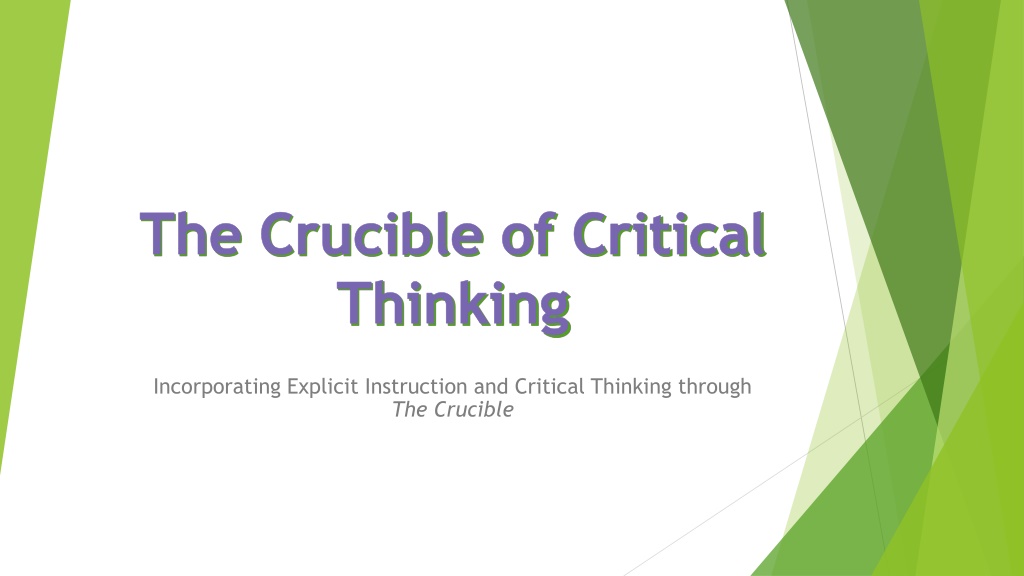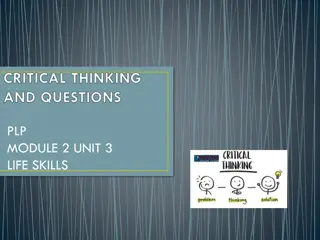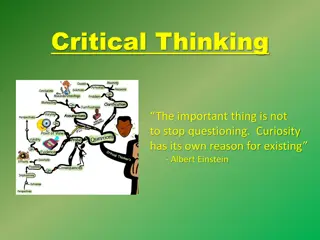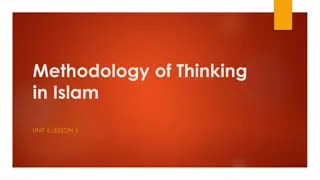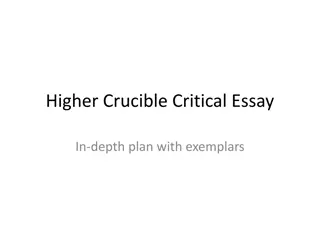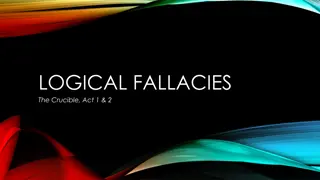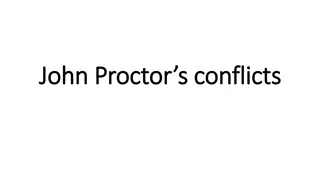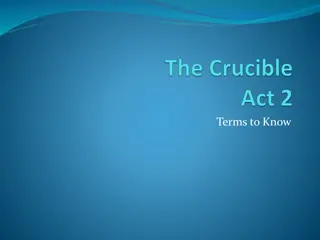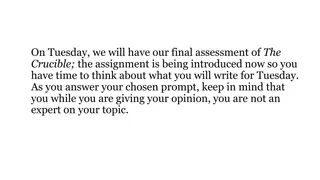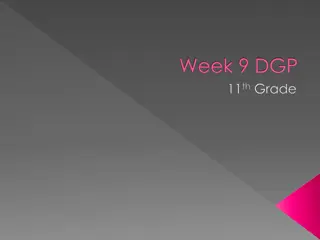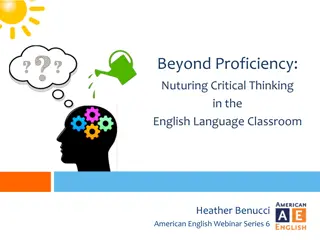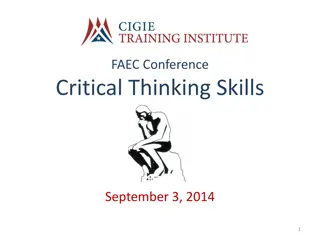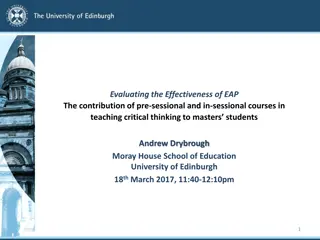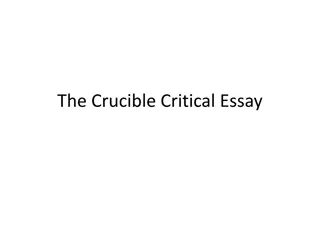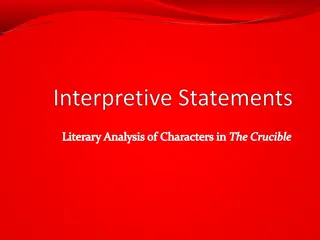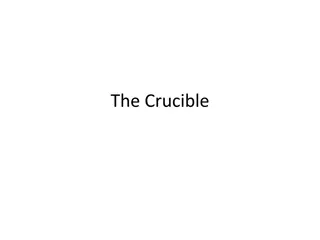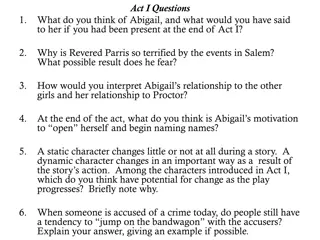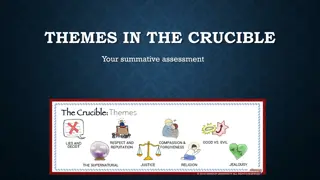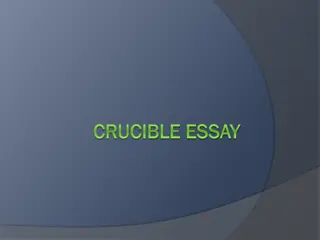Enhancing Critical Thinking Skills Through "The Crucible
Explore the integration of explicit instruction and critical thinking in teaching through the lens of Arthur Miller's play, "The Crucible." The content includes warm-up activities linking quotes to characters, insightful dialogue excerpts, a focus on critical thinking strategies, and a quest cycle approach for different school years. The goal is to remodel lesson plans to empower students with effective learning strategies and maximize their chances of success.
Download Presentation

Please find below an Image/Link to download the presentation.
The content on the website is provided AS IS for your information and personal use only. It may not be sold, licensed, or shared on other websites without obtaining consent from the author. Download presentation by click this link. If you encounter any issues during the download, it is possible that the publisher has removed the file from their server.
E N D
Presentation Transcript
The Crucible of Critical Thinking Incorporating Explicit Instruction and Critical Thinking through The Crucible
WARM UP Connect the quotes to the characters of The Crucible
Abigail, I have fought here three long years to bend these stiff-necked people to me, and now, just now when some good respect is rising for me in the parish, you compromise my very character. I have given you a home, child. I have put clothes upon your back now give me an upright answer. Your name in the town it is entirely white, is it not? ANN PUTNAM You must understand, sir that a person is either with this court or he must be counted against it, there be no road between. This is a sharp time, now, a precise time we live no longer in the dusky afternoon when evil mixed itself with good and befuddled the world. Now, by God s grace, the shining sun is up, and them that fear not light will surely praise it. REBECCA NURSE I want to open myself! . . . I want the light of God, I want the sweet love of Jesus! I danced for the Devil; I saw him, I wrote in his book; I go back to Jesus; I kiss His hand. I saw Sarah Good with the Devil! I saw Goody Osburn with the Devil! I saw Bridget Bishop with the Devil! TOM PUTNAM A man may think God sleeps, but God sees everything, I know it now. I beg you, sir, I beg you see her what she is. . . . She thinks to dance with me on my wife s grave! And well she might, for I thought of her softly. God help me, I lusted, and there is a promise in such sweat. But it is a whore s vengeance. REVEREND HALE I have laid seven babies unbaptized in the earth. Believe me, sir, you never saw more hearty babies born. And yet, each would wither in my arms the very night of their birth. I have spoke nothin', but my heart has clamored intimations. JOHN PROCTOR Mr. Parris, I think you'd best send Reverend Hale back as soon as he come. This will set us all to arguin' again in the society, and we thought to have peace this year. I think we ought rely on the doctor now, and good prayer. TITUBA How may we blame ourselves? I am one of nine sons; the Putnam seed have peopled this province. And yet I have but one child left of eight and now she shrivels! REVEREND PARRIS Here is all the invisible world, caught, defined, and calculated. In these books the Devil stands stripped of all his brute disguises. DANFORTH
FOCUS OF THE LESSON To review knowledge of Critical Thinking strategies and Explicit Instruction through the Arthur Miller play, The Crucible. Aim: Remodel a standard lesson plan, incorporating Critical thinking strategies within an Explicit Instruction structure Success criteria: Purpose: To give our students the best possible chance of success
Quest Cycle Years 7/8 Call to adventure Challenges and temptations Years 9/10 Revelation Years 11/12
So, where do we start Explicit Instruction Critical Thinking This is where the magic happens
STANDARD LESSON Standard lesson for synthesising phase Play has been read and some discussion has taken place Now, we expect students to write an essay, using the information they have DOES THIS WORK? For our good students - yes. For MOST of our students NO!
EXPLICIT INSTRUCTION Think, pair, share Look at page 2 of your booklets Identify the elements of Explicit Instruction which blend with Critical Thinking (Which of these elements would you use to FRAME a lesson using Critical Thinking) Now turn to your neighbour and discuss your findings
Explicit Instruction Elements 1. Focus instruction on critical content 2. sequence skills logically (or if not skills, knowledge they need for the task) 3. break down complex strategies into smaller instructional units 4. design organised and focused lessons 5. begin lessons with a clear statement of the lesson s goals and your expectations 6. review prior skills and knowledge before beginning instruction 8. use clear and concise language 11. require frequent responses 12. monitor student performance closely 15. help students organise knowledge
CRITICAL THINKING There are 35 dimensions of Critical Thought:- Affective strategies Cognitive strategies (Macro abilities) Cognitive strategies (Micro abilities)
Strategies to stimulate Critical Thinking Socratic questions Brainstorm Classify and categorise Compare and contrast Making connections Group work/discussion
Socratic questioning Questioning viewpoints Probe implications Questions about the questions Conceptual Clarifying questions Probing Assumption Probing Rationale, reasons, evidence
Questioning viewpoints Another way of looking at this is does this seem reasonable? What alternative ways of looking at this are there? What is the difference between and ? Why is it better than ? How are and similar?
Probing Student Implications What are the consequences of that assumption? What are the implications of ... ? How does fit with what we learned before? Why is important?
Questions about the questions Why do you think I asked this question? What does that mean?
Conceptual Clarifying questions Why are you saying that? How does that relate to what we have been talking about? What do we already know about this? What exactly does this mean?
Probing Assumption What else could we assume? How did you choose those assumptions? Please explain why/how ?
Probing Rationale, reasons, evidence How do you know this? Can you give me an example of that? Are these reasons good enough? What do you think causes ?
Brainstorm Linguistic: - traditional - lists - online - www.scriblink.com Visual/spatial: - Mind maps - hand drawn - online - bubbl.us Kinaesthetic: - Harvest strategy
Classify and categorise Tables Retrieval charts Graphic organisers
Compare and contrast Compare and contrast map www.readwritethink.org Venn Diagram www.gleancomparisonsearch.org
Make connections Text to self Text to text Text to world
Text to self What does this remind me of in my life? What is this similar to in my life? How is this different from my life? Has something like this ever happened to me? How does this relate to my life? What were my feelings when I read this?
Text to text What does this remind me of in another book I ve read? How is this text similar to other things I ve read? How is this different from other books I ve read? Have I read about something like this before?
Text to world What does this remind me of in the real world? How is this text similar to things that happen in the real world? How is this different from things that happen in the real world? How did that part relate to the world around me?
Group work/discussion Hot potato Huddle Think: Share: Refine: Publish: Reflect Silent card shuffle Discussion forum
Lesson Remodelling In groups of 1, 2 or 3/4 look at the standard lesson Decide which dimensions of Critical Thinking suit the task and write this at the bottom of the Standard Task sheet Work on the remodelled lesson plan filling in the aim, purpose, indicator of success, previous knowledge and sequence of instruction Discuss in your groups which strategy/s would best suit the task
Group presentations Anyone like to share some strategies that they used?
3:2:1 In the booklet provided fill out the 3:2:1 activity 3 things I have learned 2 interesting things 1 question you still have
Questions? Any Questions?
List of References Archer , Anita L. and Charles A Hughes. Explicit Instruction: Effective and Efficient Teaching. New York: The Guilford Press, 2011. Draper, Debbie. "Comprehension Strategies: Making Connections." 2010-2012. Hodson, Lissa and Therese Sippel. Symphony of Teaching and Learning V2. June 2011. Paul, Richard, et al. Critical Thinking Handbook: High School. A Guide for Redesigning Instruction. Rohnert Park, C.A. 94928: Centre for Critical Thinking and Moral Critique, Sonoma State University, 1989.
[[ Thank you for listening
